Offshore managed security services have been breaking geographical barriers for the past decade. From preventing crime to increasing workplace efficiency, remote guarding teams can help prioritize client safety at different premises. You do not need to watch a lot of Law & Order to know that preventing crimes involves getting into the mind of a potential perpetrator.
Let us assume for a moment that you are a carjacker eyeing a van parked outside a large parking lot beside a mall. Will it be difficult for you to sneak in from a poorly lit perimeter area and outrun a physically unfit sleepy security guard? Contrast this with an area where the remote guarding team has conducted a thorough site survey, installed strategic surveillance cameras with facial recognition and voice-down technology where it will be nearly impossible to get rid of your digital imprint captured on their security system.
As we discovered in our soon-to-be published whitepaper, “The Human Face of The Global Security Industry,” the prevalence of electronic security has undoubtedly increased over the past couple of years. One of the contributing factors for this change was the decreasing cost of hardware and software resources. Moreover, events such as riots and political unrest, forced civilians to wake up to the need for strong precautionary measures when it comes to security and protection. With rising crimes rates, citizens and security service providers have collaboratively worked towards creating a safer environment. Amidst all the transformations in electronic security, one might be curious to understand what goes on behind the scenes during the remote guarding process. As a security services agency, you may have asked yourself the following question.

The truth is, the strategic application of intelligent technology is highly effective in securing asset protection, site security and access control. In this blog, we will look closely at both traditional as well as new forms of security services and how an integrated remote guarding approach can help keep your client sites and assets safer.
Organizing effective remote guarding systems
Technology has become phenomenally sophisticated and pairing the right platforms with the right offshore team can offer security agencies the ability to offer watertight security solutions at a much lower price compared to physical guarding. However, the remote guarding systems you use and the manner in which you organize and train your remote security teams can have a significant impact on how effective your security services are for your clients.
Upcoming trends in security networks
The introduction of fifth-generation mobile telecommunications, popularly known as 5G, has set the bar high in network efficiency and speed. In addition to the lightning-fast speed and reduced latency, it is now possible to collaborate and work better with IoT devices.
The IT service management giant, Gartner states that outdoor surveillance cameras would be the biggest market for 5G IoT solutions until 2022.
Earlier, traditional security cameras were dependent on cable and fiber wired connections making the surveillance ecosystem more expensive and complex than required. The awaited technology comes as a big relief to the video surveillance industry as it will further increase the broadband capabilities providing high-resolution security footage. This also means that security teams will monitor low latency jitter-free real-time video feeds.
The arrival of the advancement of technology in security cameras such as 4k and 8K high-resolution cameras required massive bandwidth. Video surveillance connectivity to networks is helping businesses to overcome the hurdles of the past and drawing new opportunities in the video surveillance market.
Type of camera systems
Take a look at some of these camera systems that really work well in the remote guarding world.
- Dark Fighter Technology Cameras

Even in low light, these cameras have the ability to pick up colored images with the help of ½” CMOS progressive scan sensors. This is the perfect nighttime security surveillance camera and best for construction sites and warehouses.
- ANPR and LPR Cameras

These cameras are best for capturing and storing data on registration plates. ANRP stands for Automatic Number Plate Recognition and as the name suggests, it is best for the safety of your auto-dealership and parking lot clients.
- Internal and External Dome Camera

The dome camera is the most used surveillance camera. The sturdy camera is best for campus security and your residential areas. By the looks of the camera, the onlookers get confused as to the potential coverage of the camera.
- Bullet Cameras

The upper hand of this camera is it captures distance viewing making it ideal for outdoor use. This camera is best suited for clients dealing with warehouses and parking lots. These cameras are safe from dust, dirt and other natural elements.
- PTZ Pan Tilt & Zoom Camera

This camera is a bit expensive but the technology allows the camera to be moved left or right (panning), up and down (tilting) and even allows the lens to be zoomed closer or farther. These added benefits make the camera a bit pricey but again, the additional security features can keep assets and people much safer.
Features that make video surveillance a necessity
Remote guarding paired with the latest technology can be a big step towards a highly reliable security offering. Let’s take a quick look at some interesting features that security services providers can utilize to keep clients safe.
- Wide Dynamic Range
Due to the difference in lighting, a part of the image is so bright you will have trouble seeing any details due to dynamic range. Wide dynamic range (WDR) in the cameras have special software allowing them to balance that lighting for one clear image. WDR makes the footage appropriate for recording areas like entrances to retail outlets where there is a contrast between the sunshine outside and the dim lighting.
Cameras with WDR technology have advanced sensors that can produce a broader range of lighting, allowing them to record higher light depth. Cameras may face problems with overexposed and underexposed images because they can only accurately record the middle area of light between very dark and bright.
- Frame Rates
A frame rate is expressed as frames per second. FPS is the number of frames (or images) your camera can take per second. Technology is being updated as the current industry standard is 30 fps for precise, smooth video even with moving objects. A higher frame rate of 60 fps is the current target, resulting in more frames and more clarity. The only problem? You will need large storage capacity and high bandwidth.
- Remote Focus
Remote focus allows the surveillance camera to focus the camera lens if required without physically adjusting the camera or the object. In some cases, you also have an option to zoom in on the camera remotely using the focus button of the software. This advancement makes it possible to record and focus on the object, making it easier and quicker to focus your camera for clear, detailed video.
Adjust the IP surveillance camera to “remote focus” or “autofocus” in your software to sharpen the lens to give you a clear, focused image.
Physical guards vs Remote guards
Of course, different client sites will have different requirements. Knowing which technology can be applied in which situation will help security agencies assess site needs and protect client assets better. A few security providers may still be preferential towards employing physical security guards. Nothing wrong with wanting a warm body to patrol your client premises. To help you understand better, we have listed below some of the training that a physical guard undergoes.
- Physical Training
Physical training is essential training required to enhance your movement and agility. In moments of trouble and misadventures, the security guard is responsible for acting fast and catching the perpetrator. For all this tackling and fighting, he needs to stay fit and active.
- Unarmed Training
Unarmed training refers to the development of fighting skills and techniques. Sometimes, physical forces are enough to stop a chaotic mishap. Defense skills can be performed without any arms and ammunition.
- Armed Training
Armed training is a more sophisticated set of training as it involves the use of weapons and ammunition. This training is only provided to the guards to give them knowledge on its usage. The security guard must pass the training to be a licensed armed security guard.
These are great skills to have for the traditional guarding system, but modern problems require modern solutions. We have contrasted these skills with what virtual security guards bring to the table. Take a look at some of the remote guarding functions you can get with you outsource your security services to an electronic security provider.
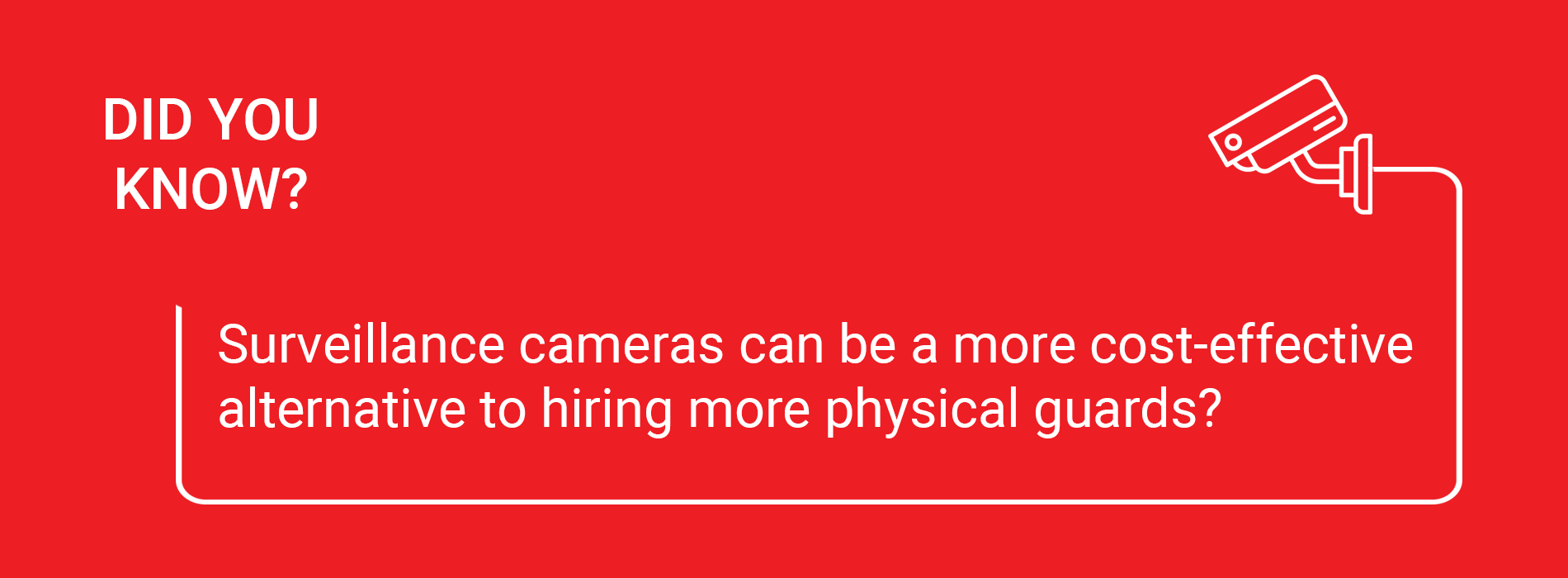
Aligning major remote security functions
Virtual guarding has picked up in the past five years. Remote guards are in high demand and yet, qualified offshore security providers are difficult to find. A significant reason for the breakdown of many hybrid onshore-offshore security relationships is the lack of strong back-office support. One way to build successful remote security partnerships with an offshore provider is to put in place vigorous training and operational structures to ensure that all major security functions handled by your offshore partner align directly with your onshore efforts. Below are a few key areas where the extra efforts to align your teams really pay off.
- PATROLLING
Patrolling has traditionally been a physical function, but more and more remote teams are introducing virtual patrol routines into their shift. A virtual guard can patrol the perimeters faster and with more frequency than a physical guard. In fact, the beauty of the virtual guarding system is that the patrolling can be made possible at any time of the day or night. At the end of the day, ensuring alignment within your patrolling functions involves activities similar to those listed below.
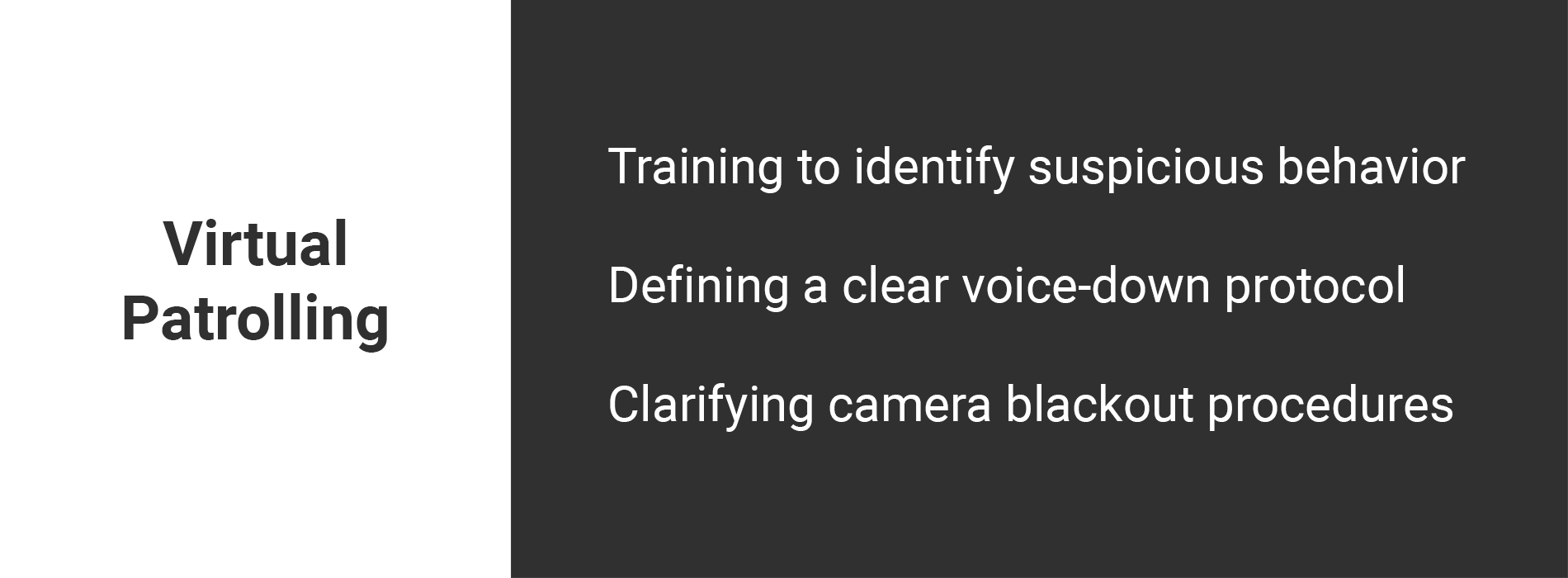
- Training to identify suspicious behavior
- Defining a clear voice-down protocol
- Clarifying camera blackout procedures
- PANIC RESPONSE
The need for after-hours security is growing. Security providers usually need remote guards during the darker hours of the day when the possibility of a crime is the highest. A well-trained virtual security engineer can ensure that client sites are under constant observation. Some of the alignment activities you can share with your incident response teams are included below.
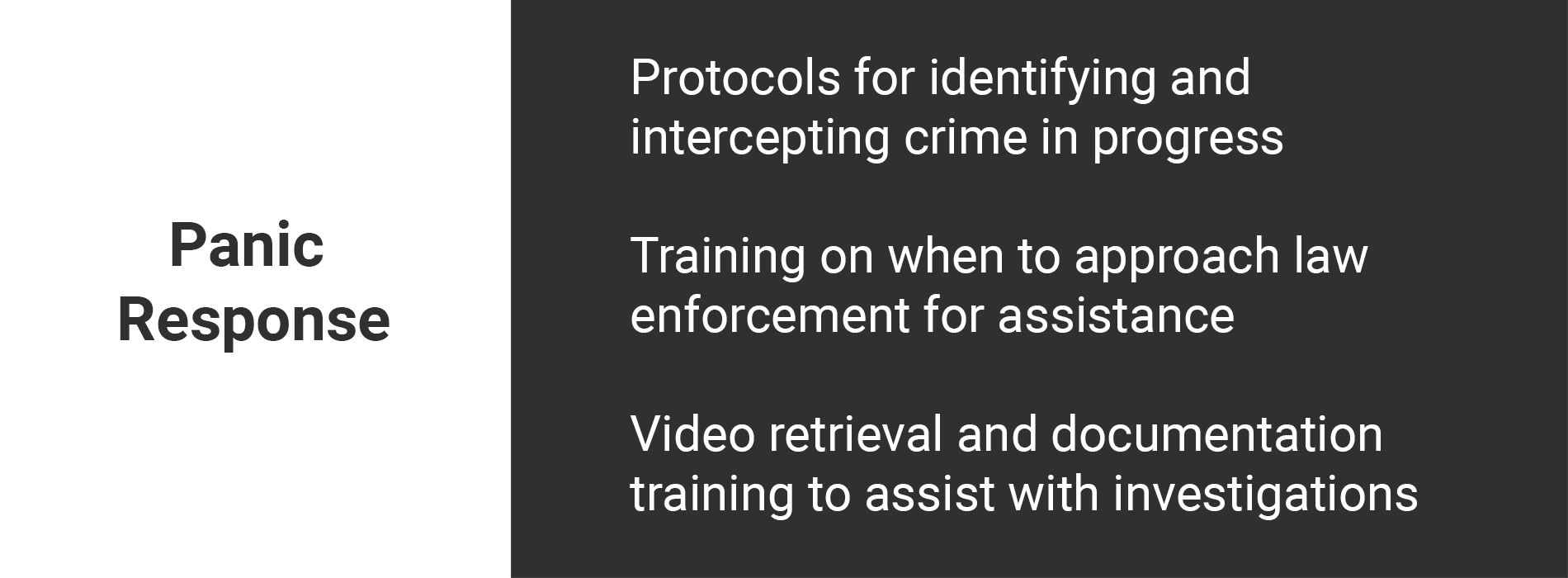
- Protocols for identifying and intercepting crime in progress
- Training on when to approach law enforcement for assistance
- Video retrieval and documentation training to assist with investigations
- GATEHOUSE SURVEILLANCE
Gatehouse monitoring or the virtual doorman is used to check visitors into a gated area or an unmanned lobby. Just like a physical guard, the virtual doorman will validate and record the entry of the visitor. Only if the predetermined requirements are met access is granted. Over the past few years, the reach for gatehouse surveillance has continually expanded to meet the demands of multiple different verticals. Below are some activities and training undergone by an offshore security guard for your commercial and residential clients for gatehouse surveillance.
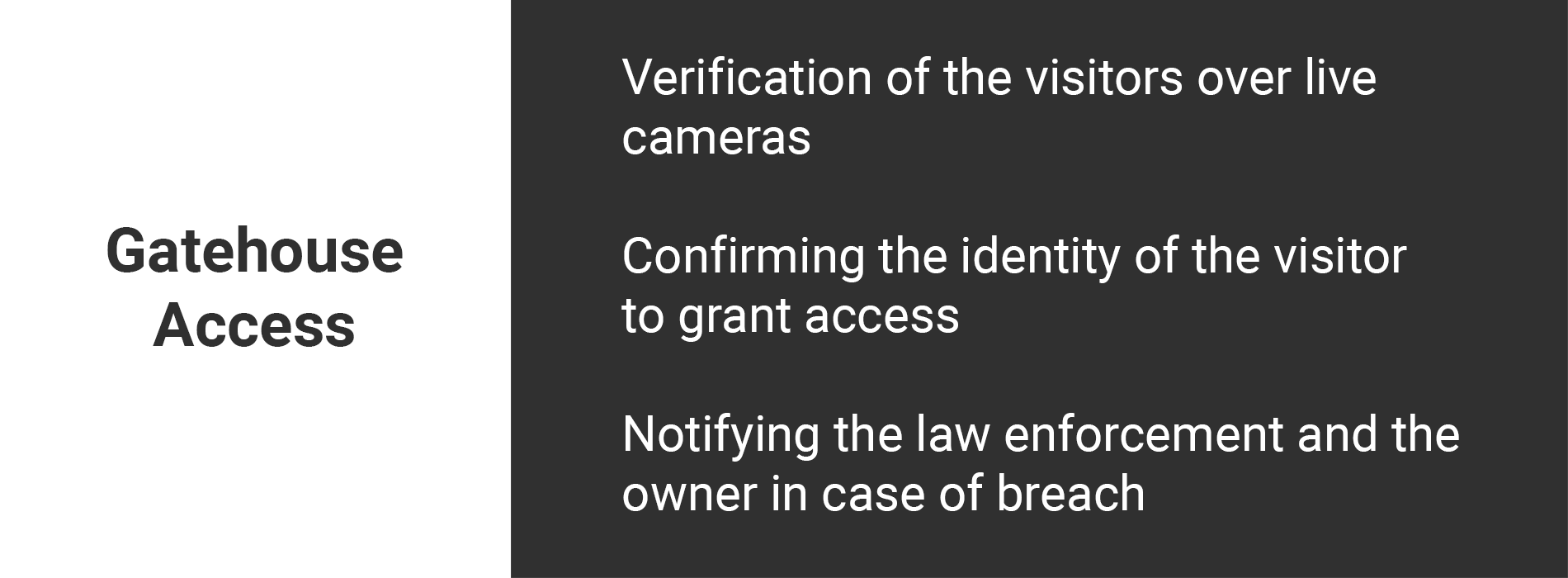
- Verification of the visitors over cameras
- Confirming the identity of the visitor to grant access
- Notifying the law enforcement and the owner in case of breach
- ALARM MONITORING
You need highly trained and experienced agents to clear pending alarms from the queue. The virtual security team deals with non-relevant nuisance alarms triggered by faulty sensors or false alarms, providing greater efficiency so that the site can deal with urgent alarms. An alarm monitoring service gives you greater peace of mind knowing that proper safety protocol is in place if an incident does occur on client premises. An efficient remote guard ensures proper alarm monitoring procedures are followed by taking care of functions such as the ones listed below.
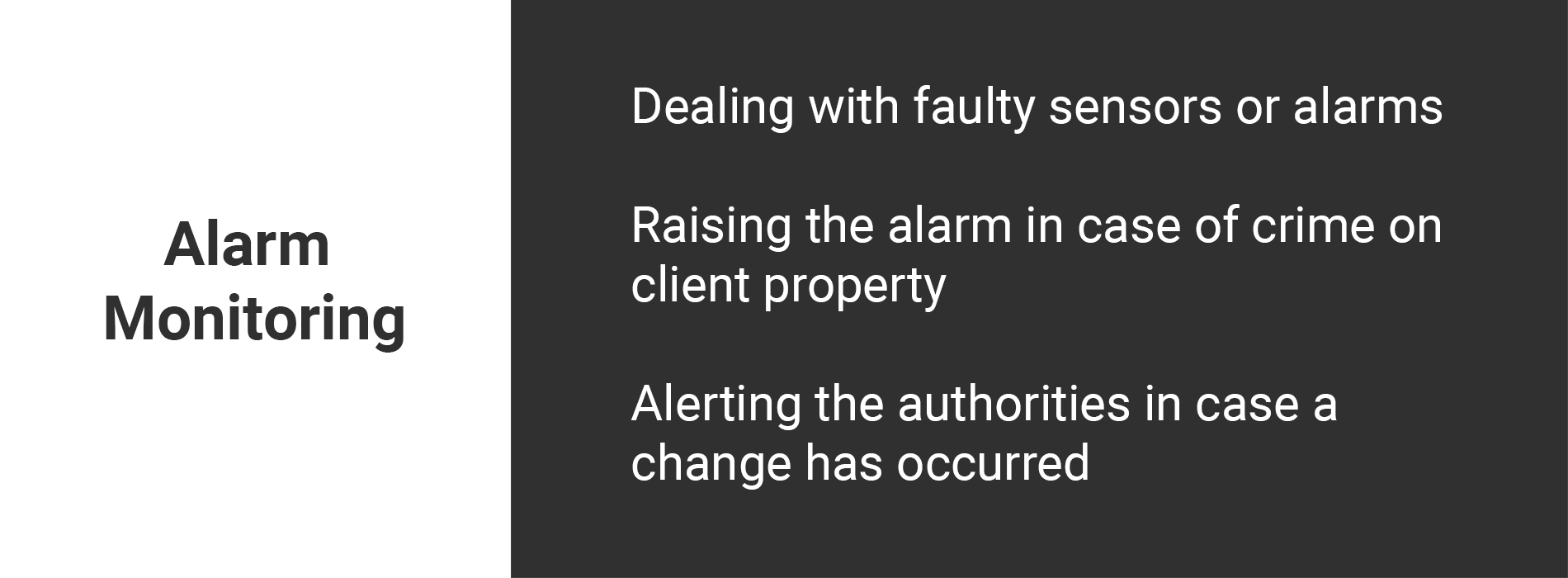
- Dealing with faulty sensors or alarms
- Raising the alarm in case of crime on client property
- Alerting the authorities in case a change has occurred
Off-site security personnel can survey multiple angles simultaneously, quickly determining the exact situation and relay the appropriate information to authorities if appropriate. Being a security provider, the safety of client property is in your hands. Healthcare institutions, warehouses, auto-dealerships, residential, corporate and other properties are safer when someone is watching these spaces 24/7/365. The combination of the latest surveillance technology paired with remote guarding practices can help security agencies provide better service, cater to more clients and ensure a safer world for all.

If you are interested in learning more about 24×7 services like alarm monitoring, video surveillance, voice-down services and after-hours support, talk to one of our security managers at info@technomine.biz today.
